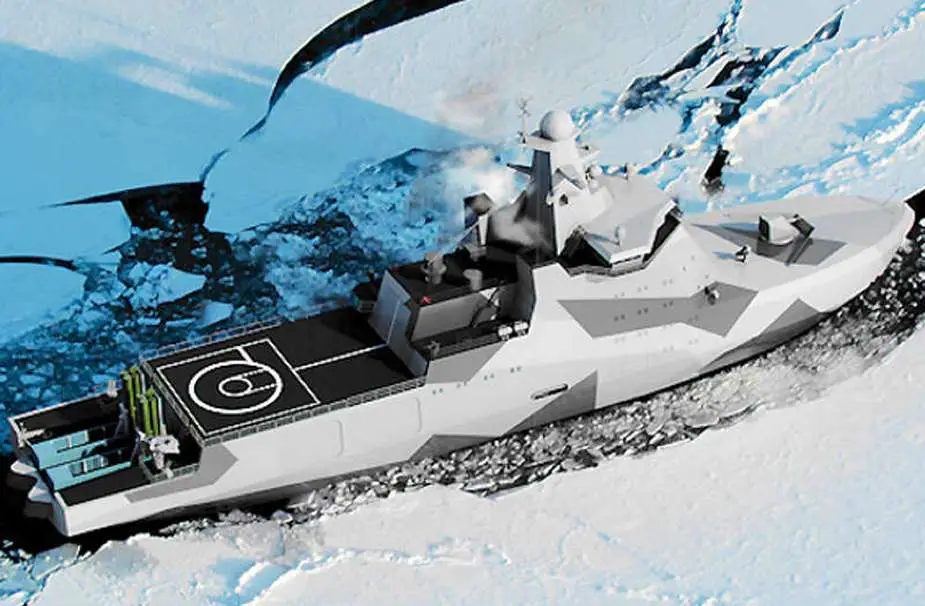Breaking news
Russian Navy to arm icebreakers with 76 or 105mm guns.
Russia already operates more icebreakers than any other country and, of course, travels along the Northern Sea Route. The country will now be arming its icebreakers with guns as part of an ongoing effort to exert more influence, station more forces and potentially claim territory in the Arctic, Kris Osborn, President, the Center for Military Modernization, writes in Warrior Maven.
Follow Navy Recognition on Google News at this link
 Artist rendering of the icebreaker project 23550 The Ivan Papanin (Illustration source: Russian MoD)
Artist rendering of the icebreaker project 23550 The Ivan Papanin (Illustration source: Russian MoD)
In recent years the Russian military has been moving more weapons, increasing patrols and even setting up bases in the Arctic region, Kris Osborn writes. Russia’s state-backed TASS news agency quotes the CEO of Krylov State Research Center saying the thickness of the ice will determine which kinds of weapons arm certain icebreakers: "There will be ice-breakers and ice-breaking ships, in other words, ships capable of moving at a sufficient speed through ice floes of a certain thickness. In fact, they will be armed icebreakers," the CEO said. "Where the ice is thin, there will be more weapons and the other way round."
TASS writes that the lead ship for the Arctic – an icebreaker of project 23550 Ivan Papanin – began to be built at the Admiralty Shipyards on April 19, 2017, and launched on October 25, 2019. “It will be armed with one 76 mm or 100 mm artillery piece”.
As it is widely known, Russian icebreakers play a crucial role in ensuring year-round navigation along the Northern Sea Route (NSR) in the Arctic region. The NSR, also known as the Northeast Passage, is a strategic maritime corridor that connects the Atlantic Ocean to the Pacific Ocean through the Arctic Ocean. This route significantly reduces the distance and transit time for ships traveling between Europe and Asia, making it an attractive alternative to the traditional Suez Canal route.
The Arctic region is known for its harsh and unforgiving climate, characterized by extreme cold, ice-covered waters, and challenging navigational conditions. During the winter months, the Arctic Ocean is frozen over, making it impassable for most vessels. However, Russian icebreakers come to the rescue, breaking through the thick ice to create a navigable path for cargo ships, tankers, and other vessels.
These icebreakers are specially designed and built to withstand the severe Arctic conditions. They are equipped with reinforced hulls, powerful engines (some of these ships are nuclear-powered), and advanced ice-breaking technology that allows them to plow through ice several meters thick. Russian icebreakers come in various classes, including nuclear-powered icebreakers, which are among the most powerful and capable in the world.
One of the most renowned Russian icebreakers is the "50 Let Pobedy" (50 Years of Victory), a nuclear-powered icebreaker that holds the distinction of being the largest and most powerful icebreaker on the planet. It can break through ice up to three meters thick with ease, ensuring safe passage for ships along the NSR.
The use of Russian icebreakers along the NSR has gained significant importance in recent years due to climate change. As Arctic ice continues to melt, the navigable season along the NSR has been extended, making it an increasingly attractive option for international shipping companies. This has led to a surge in shipping traffic through the Arctic, primarily driven by the transportation of natural resources and the opening up of new trade routes.
However, the increased activity in the Arctic also raises concerns about environmental impacts and the need for responsible and sustainable practices. Russia recently held a specialized conference raising concerns about the serious lack of enough powerful icebreakers to ensure free navigation on the Northern Route during the Winter months.
 Nuclear-powered icebreaker '50 Let Pobedy' near the North Pole (latitude 88° North) (Picture source: Wikipedia)
Nuclear-powered icebreaker '50 Let Pobedy' near the North Pole (latitude 88° North) (Picture source: Wikipedia)


























